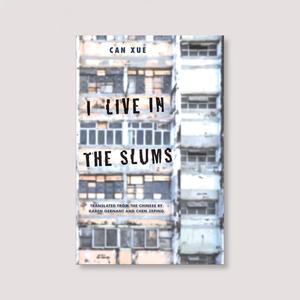I Live in the Slums, by Can Xue
translated by Karen Gernant and Chen Zeping
Yale University Press, 2020
Publisher's Blurb
Longlisted for the 2021 International Booker Prize. A major new collection of stories by one of the most exciting and creative voices in contemporary Chinese literature
Can Xue’s stories observe no obvious conventions of plot or characterization. That is the only rule they follow. Instead, they tend to limn a disordered and poetic state given structure by philosophical wonder and emotional rigor.
Combining elements of both Chinese materiality—the love of physical things—and Western abstract thinking, Can Xue invites her readers into an immersive landscape that blends empirical fact and illusion, mixes the physical and spiritual, and probes the space between consciousness and oblivion. She brings us to a place that is both readily familiar yet unmappable and can make us hyperaware of the inherent unreliability in our relationship to the world around us. Delightful, enchanting, and filled with secrets, Can Xue’s newest collection shines a light on the forces that give contours to the visible terrain we acknowledge as reality.
Reading Chinese Network Reviews
Reviewed by Lorna Amor, 9/10/23
 I Live in the Slums is a dystopian rabbit-hole of a collection of disturbing and bemusing short stories from celebrated avant-garde author, Can Xue (apparently this year’s bookies’ favourite for the Nobel Prize in Literature). It’s a kaleidoscopic exploration of whimsical mysteries, memories, secrets, quests, discoveries and interactions, in which every dark and mind-bending turn is taken, every nerve is strummed till you’re spat out at the other side, reeling. Readers are left dizzy, claustrophobic, physically uncomfortable as the stories spiral through layer upon layer of bizarre suffering, confusion, and sensory discomfort.
I Live in the Slums is a dystopian rabbit-hole of a collection of disturbing and bemusing short stories from celebrated avant-garde author, Can Xue (apparently this year’s bookies’ favourite for the Nobel Prize in Literature). It’s a kaleidoscopic exploration of whimsical mysteries, memories, secrets, quests, discoveries and interactions, in which every dark and mind-bending turn is taken, every nerve is strummed till you’re spat out at the other side, reeling. Readers are left dizzy, claustrophobic, physically uncomfortable as the stories spiral through layer upon layer of bizarre suffering, confusion, and sensory discomfort.
Can Xue’s imagined worlds are lined with neglected urban landscapes, desolate open spaces, empty buildings, doorless housing, underground lairs and shadowy alleyways that host rat-like creatures, weird neighbours, ghostly cousins, anxious birds and thoughtful trees. Descriptions are so plainly visceral you’re left gasping for air, the fresher the better, and desperate for light and space and kindness. There’s poverty and hunger, whispers, shame, and cruelty, squealing animals and feral children, all punctuated with fleeting domesticity and a simple curiosity; readers are confronted by all manner of ideas and scenarios that collide and ricochet off each other and morph into something ever more gruesome and/or strange. Each time you think you’ve found relief from the emotional fretting and psychological torment, the next hostile environment emerges from the last, and you quickly become aware that only the quickest-witted and the very lucky will survive in this dream terrain. Questions posed to and by the stories’ characters are passed on to us in the audience – this questioning and the relentless pace of the writing (especially in the first two thirds of the book, after which the stories take a less frenzied, more wistful turn) lend an insecurity that makes for an anxious read. There are commonplace characters, and there are those who are grotesque, exaggerated, and ludicrous, bringing to mind the farcical illustrations of political magazines from Victorian Britain, or the surrealist grins and eery expressions in the work of contemporary Chinese visual artists Zhang Xiaogang, Fang Lijun or Yue Minjun. Interactions in these internal worlds balance on uncanny moments and chance, other-worldly meetings, and are rarely as they seem. Or are they exactly as they seem? The contrast between the bizarreness of the big picture and the mundane nature of the individual blocks of it are disorienting and unsettling. The language used in Karen Gernant and the late Chen Zeping’s translation reflects this contrast too. The jaunty, detached style and naïve, matter-of-fact telling have a charm of their own alongside the experimental, non-sequential story arcs, and I enjoyed the acknowledgment of absurdity in the frequent use of exclamation marks.
This is not a short collection. Some of the stories are more captivating than others – the more deranged the better, it seems (my favourites were Story of the Slums, The Swamp, Catfish Pit, The Queen and Venus). Some you rush through to get to the end and find out what happens, only to be left sheepishly aware that there was never any formal plot line. There are no neat endings here. These aren’t shorts you can dip in and out of, or take too long over – zone out for a minute and you’re lost. I Live in the Slums is a veritable fairground – a wonderful, garish blend of helter-skelters, big dippers, ghost trains, spinning cups and dodgems all in equal measure. You’re not here for enlightenment, you’re here for the ride. Read this at bedtime at your peril.
Reviewed by Lorna Amor
Reviewed by Michelle Deeter, 15/12/21
 If I had to sum up I Live In the Slums in a word, I would say it was upsetting. The first story was four parts long and yet the protagonist did not seem to go anywhere. The protagonist is unsure if he is a rat or a lizard or some other animal. The rat doesn’t have a stable home and has to gauge the generosity of the families where he chooses to sleep. They can be nice to him but often they try to poison him or lock him up. Then he ends up in some kind of tunnel where everyone is shooting him. The dimensions of this hellish place are unstable, which added to my discomfort. I was constantly second guessing what I was reading. If pain described in one paragraph seems to disappear in the next paragraph, was there really pain at all?
If I had to sum up I Live In the Slums in a word, I would say it was upsetting. The first story was four parts long and yet the protagonist did not seem to go anywhere. The protagonist is unsure if he is a rat or a lizard or some other animal. The rat doesn’t have a stable home and has to gauge the generosity of the families where he chooses to sleep. They can be nice to him but often they try to poison him or lock him up. Then he ends up in some kind of tunnel where everyone is shooting him. The dimensions of this hellish place are unstable, which added to my discomfort. I was constantly second guessing what I was reading. If pain described in one paragraph seems to disappear in the next paragraph, was there really pain at all?
The other stories were more manageable both in terms of length and plot. In "Our Human Neighbors", the second story, the main magpie frets as many of his family members die, but at least he has a good relationship with his magpie wife. She is wise and offers insights into the temperamental humans that live nearby. Still, this story annoyed me because it had a tendency to write three questions in a row, just like the previous story. Posing a cluster of questions when one or two would have expressed the same idea was exhausting.
In a story called "The Swamp", the main character Ayuan wants to visit the swamp which is a place that is located under the theater but also under the playgrounds. The desire of a character to visit a potentially unreal place is a theme that author Can Xue revisited a few times in the book. When Ayuan finally arrives at the swamp he is unable to leave, until he figures out a way out. Ultimately, he comes to the realization that the swamp could be anywhere he wanted it to be.
While the characters that feature animals tend to feature more trauma and pain, the characters that feature female humans tend to go nowhere. The story called "Sin" ends with Rumei throwing away a lacquered box without ever opening it. Her husband is irritated by this, but nothing happens to either of them. In "Catfish Pit", Woman Wang doesn’t care that her house is going to be demolished along with those of her neighbors. In the story, she takes a nap, she interacts with a limited number of people, and realizes that a girl named Little Ping has become a “sexy young woman”. These stories were not upsetting but they did not seem to have a point.
Can Xue has a certain style, and I think that style was faithfully rendered in the English. I cannot comment on phrases that sounded slightly odd to me—the whole book was odd, so there was no way to tell if a certain translation choice was something that a different translator would have done differently or just something that Can Xue did to achieve a certain effect. The book was co-translated by a team that has worked together on previous projects, Karen Gernant and Chen Zeping. I wholeheartedly support co-translation of novels and believe that this can only make a work stronger.
I think the point of this book, if there is a point, is that everyone has trauma and behaves a little strangely. Perhaps the problem for me was that the book is an academic translation by an academic press. A book that has been selected for translation by an academic press is going to treat each story like a sacred source text; therefore, the stories should not be changed in the interest of clarity or reader experience. As a result, the target text is more likely to be overly long, confusing, and only suitable for a niche audience. Having grown accustomed to genre fiction translations where the translation process values the reader experience, I found this book particularly challenging.
Reviewed by Michelle Deeter
Reviewed by Riya Shah, 7/11/21
 A fragmented reality, curious intimations of tranquility and dreamlike imagery characterize I Live in the Slums, a collection of short stories from renowned experimental Chinese author Can Xue, known as the Lady Gaga of modern Chinese literature, as she continues to challenge the narrative conventions of linearity and pushes the boundaries of surrealist, absurdist literature. To even categorize her writing seems bit of a tedious task, since one can uncover traces of Kafka, Borges, Calvino, and Dante, but at the same time, one still finds distinctive creativity in her work.
A fragmented reality, curious intimations of tranquility and dreamlike imagery characterize I Live in the Slums, a collection of short stories from renowned experimental Chinese author Can Xue, known as the Lady Gaga of modern Chinese literature, as she continues to challenge the narrative conventions of linearity and pushes the boundaries of surrealist, absurdist literature. To even categorize her writing seems bit of a tedious task, since one can uncover traces of Kafka, Borges, Calvino, and Dante, but at the same time, one still finds distinctive creativity in her work.
Reading this collection was one of the most rigorous tasks I have ever had to venture into, and it took me on a roller coaster ride where it had me questioning the very nature of my reading. To understand the complexity of Can Xue’s works, one requires training in both literature and philosophy. As she herself said in an interview with Bomb magazine,
“Reading my fiction requires a certain creativity. This particular way of reading has to be more than just gazing at the accepted meanings of the text on a literal level, because you are reading messages sent out by the soul, and your reading is awakening your soul into communication with the author's...Most of my readers stop at the level of “dream reading,” which is still a conventional way of reading.”
To find this balance between ‘material thinking’ and ‘dialectical thinking’ was quite challenging but what kept me going was the unflinching belief that what the writer was up to would transcend this dilemma.
The book’s opening story Story of the Slums leaves everyone wondering who the narrator is and this confusion lingers throughout the collection. The titular novella starts, “I live in the slums. I didn’t settle firmly on one place to live”; the ambiguous and shapeshifting I changes from one story to another. In Story of the Slums, a Rat is the supposed narrator whose devolution of the self is classically Dantesque. Another riveting theme that one observes is how Can Xue takes us up and down throughout her stories, from darkness to light, dampness to dryness, slums to cities, rural to urban, and heaven to hell.
In I am a Willow Tree, the old, lonesome tree recounts his continuous struggle with the rowdy gardener. In Our Human Neighbours, a middle-aged magpie feels empathy for humans, and we see how Can Xue manages to peel away the superficial world and reveal layers of depth and meaning.
The shifting of geographical localities and roping of identity to such localities is another theme that Can Xue plays with endlessly. Shadow People is one story that moved me the most with its misty, avant-garde setting and a fable like ending. “Where had the people gone? We hadn’t gone underground, nor were we hiding inside the hollow walls.” The tone of narration is sublime and with ghostly eloquence, she has captured much of our pandemic-exacerbated anguish. Much credit needs to be given to the translators for capturing the intensity that she strives for and lucidly portraying the obscurity that hangs throughout the collection.
I Live in the Slums is a book that will probably have different meanings for different people. It is definitely not everybody’s cup of tea as it makes you question your own authority as a reader. A piece of writing as surreal as this is more like a puzzling dream that one returns to again and again and again.
Describing her writing as “an experiment without an escape route”, Can Xue herself demystifies the world that she has created. Camus once said, “The absurd does not liberate; it binds”, and indeed, no matter how idiosyncratic her style of writing is, we see a taut emotional logic present in each and every story. As promised, Can Xue invites us into an “immersive landscape that blends empirical fact and illusion, mixes the physical and spiritual, and probes the space between consciousness and oblivion.”
Reviewed by Riya Shah
Reviewed by Stella Jiayue Zhu, 20/9/21
 When surrealism emerged in the 1920s, its French pioneers invented a game called the Exquisite Corpse, which begins with the first player writing down a phrase and folding the piece of paper to partially conceal their writing. The paper is then passed around for everyone to add something, in turn, to complete a sentence. The game derives its name from, purportedly, the first sentence that came to be from this exercise: Le cadavre exquis boira le vin nouveau. (The exquisite corpse shall drink the new wine.)
When surrealism emerged in the 1920s, its French pioneers invented a game called the Exquisite Corpse, which begins with the first player writing down a phrase and folding the piece of paper to partially conceal their writing. The paper is then passed around for everyone to add something, in turn, to complete a sentence. The game derives its name from, purportedly, the first sentence that came to be from this exercise: Le cadavre exquis boira le vin nouveau. (The exquisite corpse shall drink the new wine.)
I do not know if Can Xue has heard of or played this game, but she is clearly no stranger to the principle of the matter. In her interview with Asymptote, the author reveals that she writes from a place of ‘total creativity amid a divided consciousness’. Everyday she commits a paragraph to paper, always ‘sequentially, from beginning to end’. She never rearranges. She never edits.
It’s a remarkable and remarkably unusual process, though not quite unexpected once we take in the kind of stories Can Xue writes. I Live in the Slums, her phantasmagorical collection of short stories translated by Gernant and Chen, exudes an affinity to absurdist sensibilities, manifest by the stories’ blatant disregard for ordinary notions of continuity in narrative and spacetime, their adamant refusal to fulfill any expectation for rational explanation and resolution, and a startling, Baudelairean fascination with grotesque physicality.
This preoccupation with unfathomable sights—with the sick and deformed, the dying and rotten—comes through most clearly in the infernal visions of "Story of the Slums", the titular novella about a rat-like, shapeshifting narrator’s strange, gory encounter with abominable creatures populating the plagued, waste-ridden slums.
There isn’t a singular plot as much as an overarching theme of incomplete metamorphosis, reprised over and over through Can Xue’s powerful, unrelenting depiction of hybrid beings stuck with sick, confused bodies, bleeding, dying, and happily thriving all at once. Here is an eye wrapped in membrane concealed in an abdominal cavity; there is a bamboo stick, dripping with blood, jumping twice, and becoming an alive, succulent thing.
Scene after scene, Can Xue inspires feelings of repulsion and fascination as she taps into a primitive anxiety at the core of our subconsciousness, exploiting our unease with things that defy categorization and knowledge. Is this piece of flesh man or animal, living or dead, the interior or the exterior? In "Story of the Slums", the right answer is more likely than not: both. I cannot think of anything more terrifying and enigmatic than that. To quote Yeats, what we have at hand is “a terrible beauty”. And just like the Republic’s Leontius, we cannot look away.
This paradoxical co-mingling of incompatibles persists through the ensuing stories, none of which are as long or featuring as much explicit visual perversity, but they are comparable in mystery: abundant with strange, capricious characters, oracular dialogues, sudden, inexplicable desires, disorienting landscapes, and dream-like, hallucinatory events.
While each story stands alone, a few themes make repeated appearances: the outcast migrant type driven from home (the rat-like creature in "Story of the Slums", the married magpie in "Our Human Neighbors", and the tailed-man in "Shadow People"), the exclusionary contrast between we and they ("Shadow People", "The Outsiders", "Catfish Pit"), the vague, unfulfillable yearning for a better place faraway ("Catfish Pit", "Lu-er’s Worries", "Venus"), just to name a few. The reiteration is never tedious; Can Xue’s writing always overflows with creativity and thrill. So, when collected, these stories inform each other to allow the emergence of a larger theme, where the author’s fixation on questions of identity, loss, and yearning become puzzle pieces fitting within a singular frame.
Can Xue has said in interviews that all her books are autobiographical. As I understand, it is as much an admission to drawing from personal history as an instruction to experience and interpret her works as the unadulterated, subjective vision of an auteur.
I Live in the Slums is a very challenging book. The stories’ experimental forms and uneasy imageries can prove intimidating to the unprepared. That said, as one such relatively unprepared reader, it is clear from the get-go that I am in extremely good hands: it is not hard to recognize sheer literary prowess when you see it. And thanks to the care and attention with which Gerant and Chen handled the translation, the intensity and shock of the source text is not lost. In "Story of the Slums", the rat-like narrator says about the slums, “I know all kinds of secrets here, but I don’t understand the mysteries of these secrets. On the outside, these secrets look beautiful but terrifying.” It then proceeds to ask itself, “Is this why I’m always eager to poke around?”
With some minor twists, the same may be said about the book: it contains many secrets that may not be understood, at least immediately, but be patient and let it draw you in; here lies an extraordinary vision, a rich mine for serious investigation.
Reviewed by Stella Jiayue Zhu
Reviewed by Stephanie Boote, 15/4/21
 Can Xue’s short stories evoke a world of displacement, poverty and disconnection. Showcased in this collection together these separate tales come together to create a surreal environment. Sometimes dangerous and often often upsetting to read, they nonetheless captured me as a reader and challenged my desire to pin down a straightforward narrative. These stories would appeal to those seeking Kafka-esque tales of painful transformation and surreal environments.
Can Xue’s short stories evoke a world of displacement, poverty and disconnection. Showcased in this collection together these separate tales come together to create a surreal environment. Sometimes dangerous and often often upsetting to read, they nonetheless captured me as a reader and challenged my desire to pin down a straightforward narrative. These stories would appeal to those seeking Kafka-esque tales of painful transformation and surreal environments.
The first story and titular piece "I Live in the Slums" was the hardest for me to personally read, but I do think nonetheless an excellent starting place. The tone of these stories is dark and surreal, this story establishes that quite brutally. The narrator is often as confused as the reader, without a clear sense of self or of home, and then is thrown through nightmarish environments which cause them great pain. They don’t understand the motivations of the characters they interact with and are left with only vague conclusions about how to continue in this way. They question where they came from and feel a deep sense of confusion and nostalgia for their ancestral home. I spent most of this story trying to figure out what kind of animal the narrator even was, although the humans called them a rat, the tone of the piece left me wondering if that was just a cruel nickname. I also spent a lot of the rest of this story wincing at the pain inflicted on them and the horrifying sights they witness. It’s not an easy first read, but in the context of the rest of the collection it establishes the clearest sense of place and tone in the slums.
The slums are seemingly limitless, expanding or retracting based on the narrator’s perspective. To the Willow Tree, the slum is only as wide as the garden its planted in, emphasising how trapped it is. Whereas the first story showcases a seemingly limitless rat run. Importantly, there is an emphasis on verticality in these stories, these slums are tied into modern urban architecture. Characters descend into underground tunnels which feel oppressive and dank, but there is also ascension into tower blocks. Particularly when Ms. Wen in "Euphoria", who we can assume is suffering from dementia, explores the many floors of her building, seemingly transforming at her will. One of the more palatable stories, due to Ms. Wen’s general optimism, it shows the displacement and disconnection with the earth and the outside while making the building her entire universe. These stories are packed with people who live on top of each other, but don’t seem to understand each other. The uneasy cohabitation between humans and animals is a frequent issue, in "Our Human Neighbors" the Magpies don’t understand humans at all, and yet they are drawn to them. The Cicadas of "The Old Cicada" are described as having a harmonious relationship with the trees and birds but are a nuisance to the people. Conversely, in "I Am a Willow Tree" plants freely describe their appreciation of a gardener, despite being improperly cared for. The disconnection only isolates the narrators and often emphasises their suffering.
Something which I noticed but found difficult to read is the difference between how Can Xue portrays the suffering of people compared to that of animals and plants. Humans suffer from psychological torment, they don’t understand one another and surreal situations arise from this difficulty.
A story which particularly stuck with me is "Sin" where a father dies and leaves behind a locked wooden box with no key, seemingly only for the purpose of tormenting his daughter. It is clear that something is inside the box but the mystery of what it could be as well as the father’s past drives Rumei to increasing mental distress until she wishes it was gone. Her cousins insistence that the there is some sin in the house also drives them all to feel unease and shame. The family is divided and suffering over the mystery of the box, but it is psychological torment. As uneasy this story is, there is little actual physical pain, unlike the stories concerning animals.
The way that the natural world is shown to suffer was far more difficult for me to read. Animals and trees suffer bodily hurt and feel immense pain. Can Xue describes the agony of the Willow Tree in visceral detail as it tries to grow in inadequate soil with barely enough water to carry on, to the point where continuing to live is somewhat horrifying. The rat of the first chapter is beaten and attacked, and the pain is translated into the surreal, nightmarish scenes of the underground tunnels. Can Xue’s writing argues that the process of transformation in the natural world is harrowing, that transplantation and change comes with a painful cost. It can be interpreted as a powerful message of environmental harm and it’s unsettling to read.
Can Xue’s writing stays with you, and I think this an excellent translation. I personally prefer when the rhythm of Chinese sentence structure remains despite translation, so this particularly appealed to me. Nonetheless, I found it a challenging read and wouldn’t necessarily recommend it to the faint of heart.
Reviewed by Stephanie Boote
